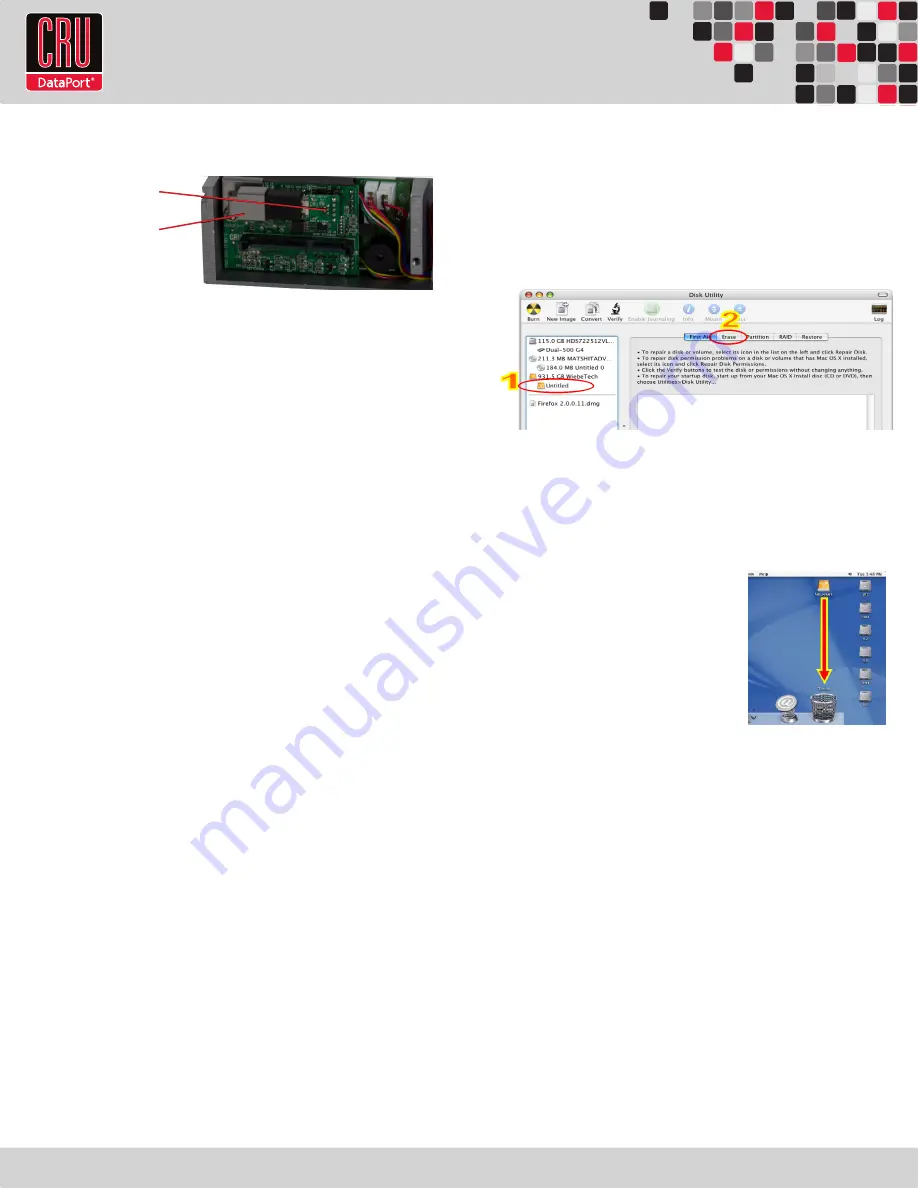
RTX220 QR - Manual
v. Fasten the Security Key bracket in place with the screw
you removed in the first step of this subsection.
c. Replace the Receiving Frame
i. Reinstall the DataPort 10 receiving frame into the SecureDock
chassis using the screws you removed when uninstalling it.
ii. Reconnect the green and blue-wired fan alarm connector
to the yellow-wired connector.
iii. Reconnect the unified power and data SATA connector to
the rear of the receiving frame.
iv. Replace the cover with the CRU DataPort logo facing
towards the front of the chassis. Place the cover onto
the chassis so that there is about an inch and a half gap
between the logo and the front of the chassis. Then slide
the cover closed.
v. Pull the two tabs on each side of the rear of the
SecureDock outward to secure the cover.
3. Usage with Mac and Windows Operating Systems
3.1 Usage with Mac OS X
3.1.1 Compatibility
The DataPort SecureDock with Internal Key supports 2.5” and 3.5”
SATA hard drives.
3.1.2 Formatting a Drive
To format, use Mac OS X’s Disk Utility (found in the applications
folder). The DataPort SecureDock with Internal Key must have been
powered on with the Security Key present and both the Power and
Encryption Ready LEDs must be lit. See Section 2.3 for instructions
on how to do so.
a. Click on the drive in the window to the left (see picture below).
b. Click the Erase tab in the window to the right (see picture
below).
c. Select the format type. Most users prefer Mac OS Extended
with Journaling (HFS+), which is required for compatibility
with Time Machine (OS 10.5 or newer). If you need to use your
DataPort SecureDock with Internal Key with both Mac and
Windows computers, select MS-DOS File System instead.
d. Enter a name for the new volume and then click “Erase” to
start the process.
3.1.3 Mounting and Unmounting Volumes
If the hard drive installed in the DataPort SecureDock with Internal
Key was previously formatted with the correct Security Key insert-
ed into the Mini-USB Security Key Port on the face of the receiving
frame, then you can begin using the volume right away. If the drive
is unformatted, a message will appear on the desktop saying that
the disk is unreadable. You can use OS X’s Disk Utility to easily
format the drive (see section above).
Unmount the volume before powering
down the unit by dragging the volume’s
icon to the trash bin, or by selecting the
volume then pressing Command-E. Dis-
connecting the unit without first unmount-
ing the volume can result in data loss.
3.1.4 Creating a Boot Drive
To activate this feature, you must first install OS X on the hard drive
in your carrier. The easiest way to do this is to clone an existing
system drive using a utility such as Carbon Copy Cloner or Super
Duper. Next, go to System Preferences --> Startup Disk. A window
will list the available bootable volumes. Select the volume from
which you wish to boot. Another method is to hold down the Option
key during boot up. A screen should appear that allows you to
select the volume you wish to use. This is useful if you wish to boot
from your DataPort SecureDock with Internal Key hard drive only
some of the time.
3.2 Usage with Windows Operating Systems
3.2.1 Compatibility
The DataPort SecureDock with Internal Key supports 2.5” and 3.5”
SATA hard drives.
3.2.2 Formatting a Drive
Page 4
Security Connector Board
Security Key Bracket








